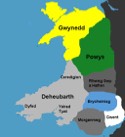Dusek Tree - Person Sheet
Dusek Tree - Person Sheet
Death844
FatherGwriad of Man King of Gwynedd (-825)
Notes for Merfyn Frych (the Freckled) King of Gwynedd
Merfyn Frych
From Wikipedia, the free encyclopedia
Jump to: navigation, search
Merfyn Frych ap Gwriad (or Merfyn the Freckled) (died 844) was a King of Gwynedd and possibly also of Powys.
Merfyn Frych seized control of Gwynedd in 825 on the death of Hywel ap Rhodri Molwynog, though he may have held power in Anglesey since 818. Merfyn was not a member of the traditional dynasty of Gwynedd, the direct male line of Maelgwn Gwynedd, and his succession marked the start of a new dynasty. His claim was apparently based on the fact that his mother, Esyllt, was the daughter of Cynan Dindaethwy ap Rhodri and the niece of Hywel ap Rhodri. According to bardic tradition, Merfyn came "from the land of Manaw", but it is uncertain whether this refers to the Isle of Man ("Ynys Manaw" in Welsh) or to Manaw Gododdin, the area around the Firth of Forth. It would seem likely that it was the latter on account of the probability he would be a blood relative of Cunedda, the founder of the Gwynedd dynasty, who was a prince of Manaw Gododdin. On the other hand there is an inscription "Crux Guriat" on a cross in the Isle of Man.[1] This cross has been dated to the eighth or ninth century and might possibly refer to Merfyn's father.
Merfyn allied himself to the royal house of Powys by marrying Nest, daughter of Cadell ap Brochwel and sister of Cyngen king of Powys. He had a reputation as a patron of scholars; for example the Historia Britonum attributed to Nennius is thought to have been written in Gwynedd during his reign, possibly by request of Merfyn himself. A manuscript found at Bamberg gives a further insight into Merfyn's scholarly interests. Irish visitors to his court were given a cryptogram which could only be solved by transposing the letters from Latin into Greek.
Despite Danish raids, Merfyn was able to maintain his position and on his death in 844 to hand the kingdom over intact to his son Rhodri the Great. He is said to have died in battle, but the circumstances are not recorded. His descendants came to rule not only Gwynedd but also Powys and Deheubarth and played a major role in Welsh politics until the end of Welsh independence in 1283.
[edit] References
Bibliography
John Davies (1994). A history of Wales. Penguin Books. ISBN 0140145818.
Lloyd, John Edward (1911), A History of Wales from the Earliest Times to the Edwardian Conquest, I (2nd ed.), London: Longmans, Green, and Co (published 1912), http://books.google.com/books?id=NYwNAAAAIAAJ&printsec=frontcover
Citations
^ Kermode, Philip Moore Callow (1897), A Welsh Inscription in the Isle of Man, in Meyer, Kuno; Stern, L. Chr., , Zeitschrift f¸r celtishe Philologie (Halle: Max Niemeyer) I: 46ñ51, http://books.google.com/books?id=_Z4MAAAAIAAJ&pg=PA46#PPA46-IA2,M1
From Wikipedia, the free encyclopedia
Jump to: navigation, search
Merfyn Frych ap Gwriad (or Merfyn the Freckled) (died 844) was a King of Gwynedd and possibly also of Powys.
Merfyn Frych seized control of Gwynedd in 825 on the death of Hywel ap Rhodri Molwynog, though he may have held power in Anglesey since 818. Merfyn was not a member of the traditional dynasty of Gwynedd, the direct male line of Maelgwn Gwynedd, and his succession marked the start of a new dynasty. His claim was apparently based on the fact that his mother, Esyllt, was the daughter of Cynan Dindaethwy ap Rhodri and the niece of Hywel ap Rhodri. According to bardic tradition, Merfyn came "from the land of Manaw", but it is uncertain whether this refers to the Isle of Man ("Ynys Manaw" in Welsh) or to Manaw Gododdin, the area around the Firth of Forth. It would seem likely that it was the latter on account of the probability he would be a blood relative of Cunedda, the founder of the Gwynedd dynasty, who was a prince of Manaw Gododdin. On the other hand there is an inscription "Crux Guriat" on a cross in the Isle of Man.[1] This cross has been dated to the eighth or ninth century and might possibly refer to Merfyn's father.
Merfyn allied himself to the royal house of Powys by marrying Nest, daughter of Cadell ap Brochwel and sister of Cyngen king of Powys. He had a reputation as a patron of scholars; for example the Historia Britonum attributed to Nennius is thought to have been written in Gwynedd during his reign, possibly by request of Merfyn himself. A manuscript found at Bamberg gives a further insight into Merfyn's scholarly interests. Irish visitors to his court were given a cryptogram which could only be solved by transposing the letters from Latin into Greek.
Despite Danish raids, Merfyn was able to maintain his position and on his death in 844 to hand the kingdom over intact to his son Rhodri the Great. He is said to have died in battle, but the circumstances are not recorded. His descendants came to rule not only Gwynedd but also Powys and Deheubarth and played a major role in Welsh politics until the end of Welsh independence in 1283.
[edit] References
Bibliography
John Davies (1994). A history of Wales. Penguin Books. ISBN 0140145818.
Lloyd, John Edward (1911), A History of Wales from the Earliest Times to the Edwardian Conquest, I (2nd ed.), London: Longmans, Green, and Co (published 1912), http://books.google.com/books?id=NYwNAAAAIAAJ&printsec=frontcover
Citations
^ Kermode, Philip Moore Callow (1897), A Welsh Inscription in the Isle of Man, in Meyer, Kuno; Stern, L. Chr., , Zeitschrift f¸r celtishe Philologie (Halle: Max Niemeyer) I: 46ñ51, http://books.google.com/books?id=_Z4MAAAAIAAJ&pg=PA46#PPA46-IA2,M1



